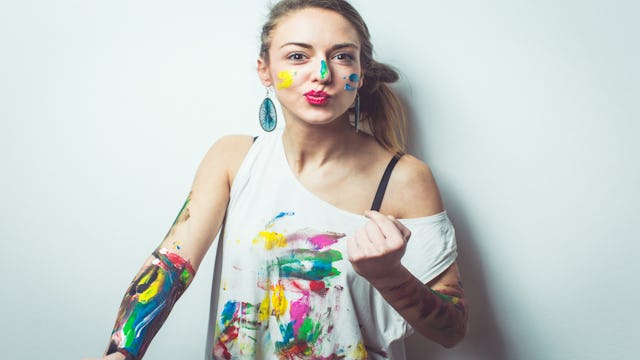Making Art Is Good For You (Even If You Suck At It)

One afternoon, stressed to the nines and home alone, I found my sons’s kiddie pottery wheel. The one I never got to use because I was always busy helping little feet pump pedals and little hands wet clay. But I was alone: no kids, no husband, no judgment.
Furtively, I brought out the grayish mass of clay, tore off a hunk, and sat at the kid’s tiny table. My thumbs pushed a divot into the top of the unformed mass. I wet everything. And I started pumping that pedal. The clay spun. And I began sculpting like a woman possessed.
Everything fell into the problems of the clay. I’m no potter, but it didn’t matter. I added more clay where it got thin; I thinned it out where it got thick. I smoothed and cupped and sculpted and scored it with some crappy plastic tools. It didn’t last long, maybe a half-hour. But at the end of that half-hour, I had made an actual freakin’ pot, misshapen or not. Something appropriate for a first-grader to gift on Mother’s Day, but what the fuck ever. It didn’t matter. I was so proud. I felt so much less stressed. And somehow, for some reason, goofily, stupidly happy.
This is not an isolated incident. In fact, researchers have found making art is good for you.
According to Business Insider, creating art can help reduce stress and anxiety. They report that a recent study in Art Therapy showed that after 45 minutes of making art, the cortisone levels in subjects’ saliva dropped — regardless of their art training or talent. Like my little pot, it doesn’t matter if your creations look like hell. It just matters that you made them.
Moreover, the Huffington Post says that researchers studying the effect of those with chronic illness and cancer making visual art found that, among other things, art “distracted thoughts of illness; improved well-being by decreasing negative emotions and increasing positive ones; improved […] trends toward depression; [caused] reductions in stress and anxiety [and led to an] increase in positive emotions.”
Um, who doesn’t want this stuff in their lives — and who doesn’t actually need it? Remember, these benefits had nothing to do with talent, no correlation with artistic merit or formal training. They were all about the benefit of simple creation.
Making art also boosts self esteem, says an essay on Be Brain Fit. You magnet your kid’s latest creation to the refrigerator door, and you may get a boost when you look at the art you’ve made too. I know I feel a little curl of pride when I see my misshapen little pot. That may be because the act of making art also increases dopamine, the “feel good” neurotransmitter. This boosts “drive, focus, and concentration,” which stimulates the creation of new neurons and “prepares your brain for learning.” This happens regardless of your art’s quality or even its medium. Crafting hobbies, including “knitting, quilting, sewing, drawing, photography, woodworking, gardening, and do-it-yourself home repair” all increase dopamine and have the same benefits for warding off depression.
Art becomes even more important if you’re sick. The Huffington Post cites a study from The Journal of Psychosomatic Medicine which found that when writing was used as a treatment for HIV patients, the patients showed a rise in CD4+ lymphocyte counts. Translation: The act of writing actually changed the cells in their bodies and improved their immune systems. This is freaking incredible.
Making art also encourages the communication between brain cells, which can help ward of diseases like Alzheimer’s. By enhancing problem-solving skills and encouraging creative thinking, it fosters cross-brain thinking (or using both the right and left hemispheres of the brain together). This is the hallmark of the most difficult human activities, like learning language and playing music.
And even adult coloring books count. CNN says that “everyone from researchers at Johns Hopkins University to the editors of Yoga Journal [suggest] coloring as an alternative to meditation.” Coloring therapy can reduce anxiety, aid focus, and create mindfulness, according says Marygrace Berberian, art therapist and clinical assistant professor and program coordinator for the Graduate Art Therapy Program at NYU. It can help relieve “free-floating anxiety” and is particularly helpful for people who aren’t comfortable making other forms of art. They don’t feel like they can screw it up, so they’re more likely to lose themselves in it.
Basically, it’s like your 5-year-old self always knew: Making art is good for your brain, your health, and your psyche. It decreases stress and depression. It can improve your health. It makes your brain cells play better together. And you don’t even have to be good at it. Even coloring counts.
So get out that kiddie pottery wheel. Find those watercolors. Buy yourself a cheesy adult coloring book. Crochet a blanket or paint a rock or sing Hamilton really loud. Or just write some stuff down. Whatever you do, making art is almost guaranteed to improve your life in some way. And remember: It’s not the finished product that counts. It’s only the effort. But in the end? You’ll probably be as proud as your melty, misshapen pot as I am of mine.